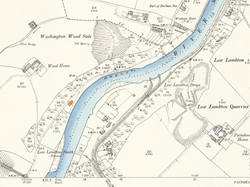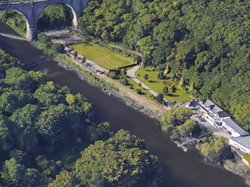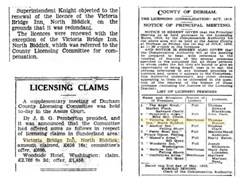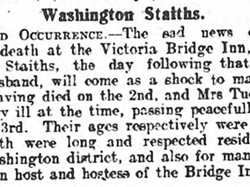The Victoria Bridge Inn
The History Society received an enquiry about the Victoria Bridge Inn that had existed on the northern bank of the River Wear, just north of The Victoria Viaduct (marked red on the 1895 Ordnance Survey map). It operated as a beer house up until 1932, and thereafter became a private residence. It is not known when it was built, but the viaduct started operating in 1838, and the Inn is on all Ordnance Survey maps from 1857 onwards. Local historian Albert Hind sketched it in his 1976 History of Washington, showing it with two substantial gables flanked by smaller cottages. The (undated) black and white photograph shows this style of construction, but the more modern aerial image shows that it has been considerably remodelled in recent years.
Cuttings from the British Newspaper Archive revealed its licence as a beer house had been declared redundant in 1932 and £600 compensation was paid to Mr Thomas Hunter.
The Inn was one of no less than 29 pubs and temperance bars between Charterhaugh to the west (where the A182 crosses the River Wear) and Cox Green to the east. Interestingly The Woodside Hotel that closed at the same time as the Victoria Bridge Inn was another riverside pub, just a few hundred yards east of the Inn (also on the map).
Working back from this date the 1911 census summary book shows the Inn was the middle of three cottages, and that the householder was Frederick Tuck, living there with his wife Alice and two children, Thomas and Mary Ellen. A third child, Hannah was born in 1912.
Tragedy struck in January 1917 when Alice died the day after Frederick, leaving three orphans. Both were interred in St George’s cemetery, Fatfield.
The enquirer informed us that Hannah, and possibly Mary, went to Dame Margaret’s Orphans' Home in Washington, but a few years later Hannah was brought up her brother, Thomas, after his marriage in 1919.
Ten years earlier Frederick and Alice were living in the Inn, when her mother, Mary Ann Hunter, was the licensee. After their deaths it appears that Alice’s brother, Robert Hunter, took over the Inn, and it was his son, Thomas Hunter, who was the final licensee.
In both the 1891 and 1881 censuses widow Mary Ann Hunter was the beer house keeper, and in 1871 it was presumably her husband, Thomas, though his occupation was given as a gardener.
Earlier records indicate Thomas and Mary Ann (Wilkinson) married in Moreland, Westmoreland in 1864. Their son Thomas was born there in 1865, but their daughters Hannah and Elizabeth were registered in Sunderland in 1867 and 1870.
However Thomas’s father was Robert born in Hexham, and he was living with them in 1881 in a cottage adjoining the inn in 1871. The 1861 census does not identify the buildings, but there is a Robert and Ann Hunter listed as Inn Keepers and Gardeners in the North Biddick township. So it appears Thomas and Alice joined her parents in the Inn, possibly soon after their marriage in 1900.
There was a second public house called The Victoria in the North Biddick area. This one was in the Victoria Place terrace next to the Washington Iron Works, just north of the Washington South Rail Junction, about a third of a mile north west of the inn. Tragically the daughter of the landlord, Ethel Gilhespy, drowned aged 21 in the River Wear in May 1902.
An informant has kindly told us that, in 1938, the license of this Victoria Inn was transferred to The Villa at the Oxclose Road/ Biddick Lane junction. It had been owned by Washington ironmaster Joseph Cook. It was demolished and replace with the Victoria Inn we see today.
While the story of this establishment is not that different from others on the river the most remarkable finding is that just one family, the Hunters, were the Inn Keepers from at least 1861 right through to it’s closure as a beer house in 1932.
The History Society would like to learn of the stories of other taverns on the river. If you can help please contact us at washingtonhistorysoc@gmail.com









